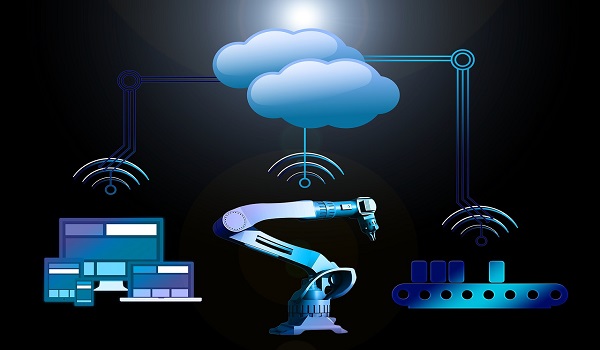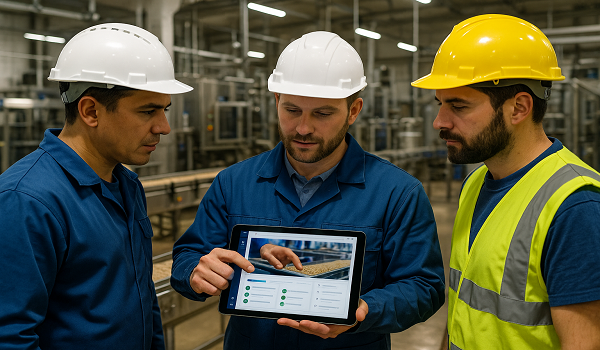Is smart industry truly transforming manufacturing production? Absolutely. This technological revolution is redefining how we conceive the factory of the future. But what exactly is smart industry? First and foremost, it’s the integration of advanced digital technologies into industrial processes. At first glance, this may seem complex. In reality, it’s the key to your future competitiveness. Today, 67% of manufacturing companies invest in industrial digital transformation. Why? Because they face major challenges: shortage of skilled workforce, growing quality requirements, cost pressures.
Among the key enablers of this transformation, industrial data automation plays a central role in ensuring real-time responsiveness, optimized workflows, and data-driven decision-making.
In the next few minutes, discover how to transform your production. We’ll explore the technologies, concrete benefits, and especially how Picomto materializes this transformation.

Key Takeaways about Smart Industry:
- Smart industry combines IoT, AI and data to optimize production
- Concrete gains: +30% productivity, -40% errors, -25% maintenance costs
- Key technologies: connected sensors, augmented reality, predictive maintenance
- Picomto digitalizes your work instructions to materialize this transformation
- Fast ROI: visible results in 3-6 months according to our case studies
1. What is Smart Industry in Digital Transformation?
Smart industry represents the natural evolution of manufacturing production. Indeed, it integrates connectivity, automation and real-time data analysis. Unlike traditional automation, it creates an intelligent and adaptive ecosystem.
1.1. Smart Industry vs Industry 4.0: What Concrete Difference?
First, let’s clarify a frequent confusion. Industry 4.0 and smart industry are often used interchangeably. However, nuances exist.
Industry 4.0 designates the fourth industrial revolution. It focuses on digitalization and connectivity. Data digitalization, in particular, is a key pillar of this transformation, enabling seamless integration between systems and real-time decision-making.
Smart industry goes further. It emphasizes artificial intelligence and autonomous optimization.
As a notable example, the digital transformation in the chemical industry illustrates how smart industry technologies can enhance regulatory compliance, operational safety, and process optimization in even the most demanding sectors.
In essence:
- Industry 4.0 = Connecting machines and systems
- Smart industry = Making these systems autonomous and predictive
1.2. Why Your Smart Factory Can No Longer Wait for this Transformation?
The figures speak for themselves. According to McKinsey, companies adopting smart industry observe:
- +20 to 30% increase in productivity
- -40% reduction in quality defects
- -25% decrease in maintenance costs
Moreover, the skills shortage is intensifying. By 2030, French industry will lack 250,000 qualified operators. Smart industry responds to this challenge by optimizing existing processes.
2. What Key Technologies Compose Smart Industry?
The technological pillars of smart industry radically transform factories. In fact, these innovations create an ecosystem where each element communicates intelligently.
2.1. How Does Industrial IoT Revolutionize Your Production?
Industrial IoT constitutes the nervous system of smart industry. Effectively, connected sensors collect data continuously. This information then feeds decision-making systems.
Concretely, here are the applications:
- Equipment monitoring: temperature, vibrations, wear
- Product traceability: real-time production tracking
- Energy optimization: 15% consumption reduction
Link with Picomto: IoT data automatically triggers appropriate procedures. Thus, the operator receives the right instruction at the right time.
2.2. Why Does Artificial Intelligence Become Indispensable in Manufacturing?
Industrial AI analyzes the masses of collected data. Moreover, it predicts breakdowns before they occur. This capability transforms reactive maintenance into predictive maintenance.
Concrete AI applications:
- Computer vision: automatic defect detection
- Process optimization: real-time parameter adjustment
- Demand prediction: adaptive production planning
Link with Picomto: AI recommends the best procedures according to context. For example, it adapts instructions according to operator experience.
2.3. How Does Augmented Reality Transform Industrial Training?
Industrial augmented reality superimposes digital information on the real world. Consequently, operators access contextual instructions instantly. This technology revolutionizes training and maintenance.
AR benefits:
- Accelerated training: 40% reduction in learning time
- Error reduction: real-time visual guidance
- Remote expertise: distance assistance from experts
Link with Picomto: Our platform easily creates AR-compatible supports. Instructions display overlaid on connected glasses.
3. What Concrete Benefits Do You Obtain with Smart Industry?
Smart industry generates measurable gains immediately. Effectively, companies observe improvements in all departments. Let's examine these benefits department by department.
3.1. How to Boost Your Industrial Productivity by 30%?
Productivity constitutes the first visible benefit of smart industry. Indeed, process optimization eliminates waste. Furthermore, automation frees time for value-added tasks.
Productivity levers:
- Downtime reduction: predictive maintenance avoids 85% of unexpected breakdowns
- Cadence optimization: real-time adjustment according to demand
- Increased flexibility: rapid production line reconfiguration
3.2. How to Drastically Reduce Your Quality Defects?
Smart industry transforms quality management. Truly, it shifts from reactive control to proactive prevention. Thanks to sensors and AI, deviations are detected immediately.
Quality improvements:
- Complete traceability: tracking of each production step
- Automated controls: integrated process verifications
- Preventive alerts: anomaly detection before product impact
3.3. How to Reduce Your Maintenance Costs by 25%?
Predictive maintenance revolutionizes equipment management. In fact, it replaces systematic preventive maintenance with a real-state-based approach. This approach optimizes costs and availability.
Maintenance optimizations:
- Breakdown prediction: intervention before failure
- Planning optimization: intervention grouping by zone
- Extended lifespan: just-necessary maintenance
4. How Does Picomto Materialize Smart Industry in Your Factory?
Picomto transforms your work instructions into smart industry levers. Indeed, our SaaS platform entirely digitalizes the value chain around procedures.
Thus, you move from static instructions to an intelligent ecosystem.

4.1. How to Intelligently Digitalize Your Work Instructions?
First, Picomto simplifies digital instruction creation. Our intuitive interface allows rapid creation of enriched procedures. In fact, our templates accelerate the process by 70%.
Key functionalities:
- Visual creation: drag-and-drop, integrated media
- Automatic versioning: modification traceability
- Validation workflow: structured approval process
Next, distribution becomes intelligent. Picomto delivers the right information to the right person at the right time. For example, an operator automatically receives the procedure according to their position and authorizations.
4.2. What Are the Revolutionary Use Cases of Smart Industry?
Picomto adapts to all smart industry needs. In particular, our solutions cover production, maintenance, quality and training. Each department benefits from contextualized instructions.
Connected operating procedures:
- Interactive assembly guides with checkpoints
- Assembly procedures with enriched media
- Control instructions with visual criteria
Intelligent predictive maintenance:
- Automatic procedure triggering according to IoT alerts
- Intervention guides with augmented reality
- Experience feedback capitalization
Industry 4.0 operator training:
- Adaptive e-learning modules
- Practical field evaluations
- Personalized skills tracking
Haleon revolutionized its training with Picomto. New operator integration time decreased considerably. Moreover, standardization guarantees training quality.
4.3. How to Measure the Impact of Your Intelligent Instructions?
Picomto provides advanced analytics on instruction usage. In fact, our dashboard reveals bottlenecks and improvement opportunities. This data feeds continuous improvement.
Available KPIs:
- Execution time: critical step identification
- Error rates: procedure friction points
- Compliance: quality standard adherence
Ready to transform your production? Discover how Picomto materializes smart industry in your factory.
Conclusion
Smart industry is no longer a futuristic vision. It’s an accessible reality already transforming factories.
In fact, mature technologies enable immediate adoption with rapid return on investment. Benefits are measurable: +30% productivity, -40% errors, -25% maintenance costs. Moreover, smart industry responds to current competitiveness and skills shortage challenges.
Picomto acts as a catalyst for this transformation. Thanks to our digital consulting for industrial companies, we help manufacturers structure their transformation roadmap, choose the right technologies, and build the foundation for a truly intelligent factory. Our platform digitalizes your work instructions to create an intelligent ecosystem. Thus, you move from a reactive approach to proactive optimization.
FAQ
What is smart industry?
The integration of IoT, AI and analytics to automatically optimize modern industrial production.
What is industrial intelligence?
The use of data and algorithms to improve real-time operational decisions.
What is Industry 4.0 and smart manufacturing?
Industry 4.0 connects machines. Smart manufacturing adds AI for autonomy.
What is the purpose of intelligence?
To optimize processes, reduce errors and increase overall industrial productivity.
What is the utility of artificial intelligence at the industry level?
To predict breakdowns, optimize quality and automate complex production decisions.
What relationship exists between Industry 4.0 and digital transformation?
Industry 4.0 constitutes the technological dimension of manufacturing companies' digital transformation.
What are the advantages of AI in factories?
Predictive maintenance, automated quality control, energy optimization and human error reduction.






Leave A Comment